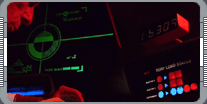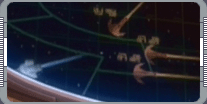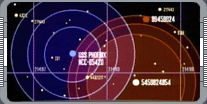
Transponder Signals and Prefix Codes
Starfleet vessels transmit a transponder signal that can be used to identify them. Prefix codes prevent
unauthorized personnel from taking control of the ship's computers.
 Starfleet uses a system of transponder codes to idetify and locate its starships across the vast reaches of
space. All Federation vessels are equipped to emit a trasponder code. This is a kind of IFF signal, which
stands for Identification: Friend or Foe, a phrase that originates with the early black-box transponders
installed in aircraft on Earth in the 20th century.
Starfleet uses a system of transponder codes to idetify and locate its starships across the vast reaches of
space. All Federation vessels are equipped to emit a trasponder code. This is a kind of IFF signal, which
stands for Identification: Friend or Foe, a phrase that originates with the early black-box transponders
installed in aircraft on Earth in the 20th century.
Transponder codes in the 24th century transmit basic information about a vessel. This often includes the
ship's name, its political allegiance, and its class. Because transponder codes are normally broadcast over
subspace, they can be used to locate a ship over very long distances, and therefore overcome many of the
limitations of sensor systems. Transponder codes can be extremely useful when a group of ships are acting
together, since they enable the fleet's commander to instantly identify each vessel under his or her command
and to see exactly how they are deployed. Federation vessels automatically cross-reference transponder
codes with onboard computer records and sensor data to gain a detailed picture of an approaching vessel. The
use of transponder codes is widespread among other races, but for tactical reasons the codes are not broadcast
openly. Transponders are not intended to allow anybody and everybody to locate a ship; cloaked vessels, for
example, do not transmit them. Transponder codes are normally only transmitted over subspace in code. This
prevents enemy ships from using them to track vessels indiscriminately, and ensures that military vessels
retain a tactical advantage. On occasion, Starfleet has gained access to the codes used by their opponents
to protect transponder information - in 2367, the USS Enterprise
NCC-1701-D was able to detect all Cardassian transponder codes across subspace. This gave them a
significant tactical advantage as Starfleet vessels were able to observe the deployment of the entire
Cardassian fleet.
Of course, transponder codes are not the only way to identify a vessel. 24th century sensor systems are
extremely sophisticated and, at close range, can gather enough data to identify any known vessel. If a ship
enters a heavily developed area, a network of sensors on board ships, space stations, and planetary
installations can be used to relay information to a tactical operations center. All this effort achieves the
same result as a single subspace receiver picking up a coded transponder signal.
 However, it is not impossible to deceive sensors. One of the primary means of identifying a ship is by using
its warp signature, and ships can be modified to emit fake ones. When a Maquis group led by Thomas Riker
stole the USS Defiant NX-74205, they programmed at least one Maquis ship
to transmit the Defiant's warp signature. As a result, the Cardassians wasted valuable resources attempting
to engage an insignificant vessel, while the Defiant was free to attack anohter target. The deception was
uncovered by Captain Sisko, who noticed that there were discrepancies in the subspace variance. Riker clearly
disabled the Defiant's transponder - Starfleet were cooperating with Cardassians, but were unable to track the
Defiant, even when she was not cloaked. Transponders can prove extremely useful if a ship is damaged or
destroyed. In these circumstances, the ship's flight recorder transmits a transponder signal across subspace,
allowing it to be located and retrieved as soon as possible. Transponders are invaluable in this kind of
situation, because if a ship is severely damaged it may not be generating any of the energy signatures that
can be used to locate vessels.
However, it is not impossible to deceive sensors. One of the primary means of identifying a ship is by using
its warp signature, and ships can be modified to emit fake ones. When a Maquis group led by Thomas Riker
stole the USS Defiant NX-74205, they programmed at least one Maquis ship
to transmit the Defiant's warp signature. As a result, the Cardassians wasted valuable resources attempting
to engage an insignificant vessel, while the Defiant was free to attack anohter target. The deception was
uncovered by Captain Sisko, who noticed that there were discrepancies in the subspace variance. Riker clearly
disabled the Defiant's transponder - Starfleet were cooperating with Cardassians, but were unable to track the
Defiant, even when she was not cloaked. Transponders can prove extremely useful if a ship is damaged or
destroyed. In these circumstances, the ship's flight recorder transmits a transponder signal across subspace,
allowing it to be located and retrieved as soon as possible. Transponders are invaluable in this kind of
situation, because if a ship is severely damaged it may not be generating any of the energy signatures that
can be used to locate vessels.
Federation vessels use another code which is vital to the ship's security. This code is known as the prefix
code and is designed to prevent an enemy vessel from remotely taking control of the Federation vessel's
computer systems. Every Starfleet vessel is assigned its own unique code when it is launched. All Starfleet
ships carry a record of all the prefix codes, and in an emergency they can be used to take control of
another vessel. The prefix codes are seldom used, but there have been instances where knowledge of another
ship's prefix code has been instrumental in winning a battle - or preventing a war.
In 2285, the USS Reliant NCC-1864, under the command of Captain Terrell, was on a mission to survey planets
as part of the Genesis Project when it was hijacked by the superhuman Khan Noonien Singh. While masquerading
as a friendly Starfleet vessel, Khan maneuvered the Reliant to within point-blank firing range of the
USS Enterprise NCC-1701 and opened fire with phasers. Knowing
the exact areas on the Enterprise to target, Khan disabled the vessel and left it a sitting duck as he
prepared to destroy it along with his arch-enemy Admiral Kirk. Kirk's experience allowed him to survive the
situation. He gained control of the Reliant's computers by transmitting the Reliant's prefix code from the
Enterprise to the Reliant. As soon as it was transmitted, Kirk was able to take direct control of the
Reliant's computers, override Khan's bridge controls and lower the Reliant's shields. Before Khan could go
to manual override, the Enterprise was able to cripple the ship.
 In 2367, Captain Picard revealed the prefix code of the Starfleet vessel USS Phoenix NCC-65420 to Cardassian
authorities. He decided on this course of action because the Phoenix's commanding officer, Captain Maxwell,
was undertaking a series of unauthorized attacks on Cardassian targets. The prefix codes gave the
Cardassians the ability to remotely disable the Phoenix's shields, but Maxwell responded quickly and still
defeated a Cardassian warship. Starfleet officers can also use their personal command codes to remotely
access the ship's computers. It is standard procedure to alter these codes if an officer is captured. In 2367, Captain Picard revealed the prefix code of the Starfleet vessel USS Phoenix NCC-65420 to Cardassian
authorities. He decided on this course of action because the Phoenix's commanding officer, Captain Maxwell,
was undertaking a series of unauthorized attacks on Cardassian targets. The prefix codes gave the
Cardassians the ability to remotely disable the Phoenix's shields, but Maxwell responded quickly and still
defeated a Cardassian warship. Starfleet officers can also use their personal command codes to remotely
access the ship's computers. It is standard procedure to alter these codes if an officer is captured.
|
|
"TRANSPONDER SIGNALS AND PREFIX CODES" - JANUARY 2000 ISSUE 9 STAR TREK: THE MAGAZINE COPYRIGHT OF PARAMOUNT
PICTURES.
|